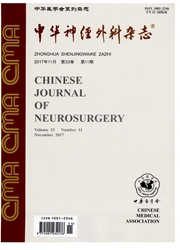

 中文摘要:
中文摘要:
目的评价在血氧水平依赖性功能磁共振(BOLD—fMRI)精确引导下的大脑白质纤维束示踪技术(DTr)结合术中导航、B超对涉及手运动传导束附近占位性病变手术的应用价值。方法20例位于手运动传导束附近的占位性病变患者,术前进行常规3DT1轴位全脑容积图、fMRI及DTI扫描。图像处理过程中,采用双感兴趣区示踪纤维束,将fMRI激活区作为纤维束示踪的起始感兴趣区,将大脑脚作为目标感兴趣区,在fMRI引导下对受病变影响的手运动传导束进行精确的纤维束示踪,结合神经导航进行术前、术中定位,并利用B超对病变切除过程进行指导,在最大范围切除病变的同时保护运动传导束。结果16例镜下全切除,4例大部分切除。20例术后复查fMRI及DTT并且进行精确示踪后可见手运动传导束保护完好。结论在fMRI引导下的DTY技术可以显著提高受病变影响的手运动传导束显像的准确性,可视化的显示纤维束走行及与肿瘤的关系,有利于优化术前个体化手术方案,术中合理应用导航、B超,可降低术后致残率,提高术后患者生存质量。
 英文摘要:
英文摘要:
Objective To evaluate the value of incorporating tMRI into DTF in the operational assessment of lesions involving the motor hand representation tracts in patients. Methods 20 patients with lesions involving the motor hand representation tracts underwent 3D Tl-weighted imaging for anatomical reference, a gradient echo planar imaging sequence for fMRI, and a spin echo-echo planar imaging sequence for DTI. We used two regions of interest (ROI) to define 3D connectivity maps within the whole brain, from seed points selected in the white matter adjacent to the location of the maximum of fMRI activation, and the target region of interest (ROI) was placed in the cerebral peduncle. During surgery, the border of the tumor was identified using neuronavigation and intraoperative ultrasonography for protecting deep white matter and enhancing the accuracy of resection. Results Total lesion resection was achieved in 16 patients, and subtotal resection in 4 eases. In 20 patients, we successfully tracked the motor hand representation tracts by choosing seed and target regions of interest on the path of the fibers. Moreover, no obvious harmful effects to the motor areas and adjacent fibers were observed in all patients. Conclusions fMRI-driven DrfT can provide the ability to evaluate the spatial relationship between the motor tracts and tumor borders. Not only has the new technology provided a maximum benefit in surgical treatment and improved preoperative planning, it also enhanced the accuracy of postsurgical outcomes.
 同期刊论文项目
同期刊论文项目
 同项目期刊论文
同项目期刊论文
 期刊信息
期刊信息
